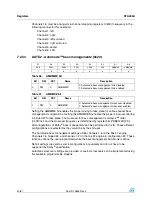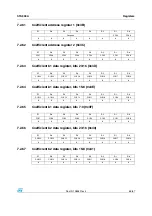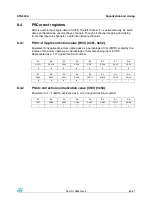
Registers
STA309A
48/67
Doc ID 13855 Rev 4
7.2.49
Limiter 1 attack/release threshold (0x30)
7.2.50
Limiter 2 attack/release rate (0x31)
7.2.51
Limiter 2 attack/release threshold (0x32)
7.2.52 Bit
description
The STA309A includes two independent limiter blocks. The purpose of the limiters is to
automatically reduce the dynamic range of a recording to prevent the outputs from clipping
in anti-clipping mode or to actively reduce the dynamic range for a better listening
environment such as a night-time listening mode which is often needed for DVDs. The two
modes are selected via the DRC bit in Configuration Register B, bit 7 address 0x02. Each
channel can be mapped to either limiter or not mapped, meaning that channel will clip when
0 dBFS is exceeded. Each limiter will look at the present value of each channel that is
mapped to it, select the maximum absolute value of all these channels, perform the limiting
algorithm on that value, and then if needed adjust the gain of the mapped channels in
unison.
The limiter attack thresholds are determined by the LnAT registers. It is recommended in
anti-clipping mode to set this to 0 dBFS, which corresponds to the maximum unclipped
output power of a DDX amplifier. Since gain can be added digitally within the STA309A it is
possible to exceed 0 dBFS or any other LnAT setting, when this occurs, the limiter, when
active, will automatically start reducing the gain. The rate at which the gain is reduced when
the attack threshold is exceeded is dependent upon the attack rate register setting for that
limiter. The gain reduction occurs on a peak-detect algorithm.
The release of limiter, when the gain is again increased, is dependent on a RMS-detect
algorithm. The output of the volume/limiter block is passed through a RMS filter. The output
of this filter is compared to the release threshold, determined by the Release Threshold
register. When the RMS filter output falls below the release threshold, the gain is again
increased at a rate dependent upon the Release Rate register. The gain can never be
increased past it's set value and therefore the release will only occur if the limiter has
already reduced the gain. The release threshold value can be used to set what is effectively
a minimum dynamic range, this is helpful as over-limiting can reduce the dynamic range to
virtually zero and cause program material to sound lifeless.
In AC mode the attack and release thresholds are set relative to full-scale. In DRC mode the
attack threshold is set relative to the maximum volume setting of the channels mapped to
D7
D6
D5
D4
D3
D2
D1
D0
L1AT3
L1AT2
L1AT1
L1AT0
L1RT3
L1RT2
L1RT1
L1RT0
0
1
1
0
1
0
0
1
D7
D6
D5
D4
D3
D2
D1
D0
L2A3
L2A2
L2A1
L2A0
L2R3
L2R2
L2R1
L2R0
0
1
1
0
1
0
1
0
D7
D6
D5
D4
D3
D2
D1
D0
L2AT3
L2AT2
L2AT1
L2AT0
L2RT3
L2RT2
L2RT1
L2RT0
0
1
1
0
1
0
0
1






























